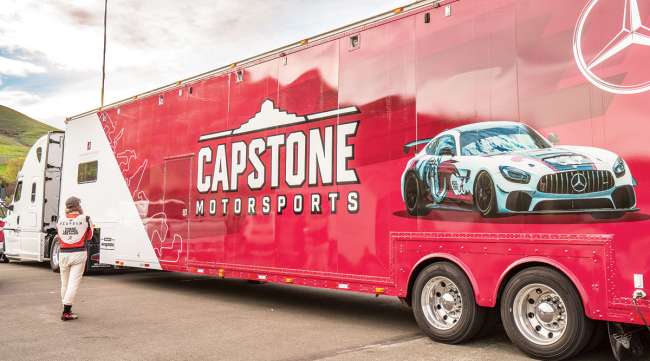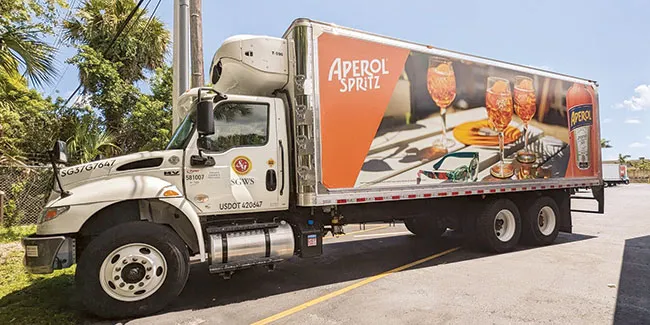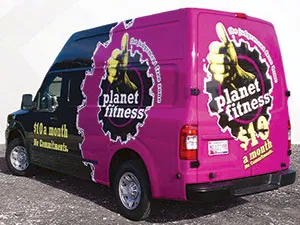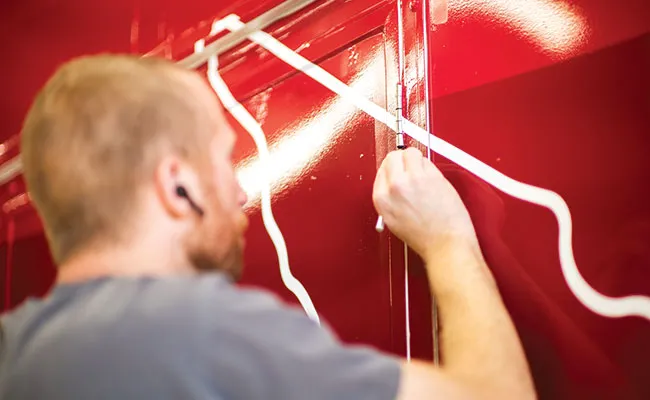Features Coordinator
Wrapped Trailer Designs Help Fleets With Brand Recognition

[Stay on top of transportation news: Get TTNews in your inbox.]
No matter the niche industries businesses participate in, juggling the wide variety of responsibilities that come with operating any business is key to its continued success. In the case of many trucking companies, juggling can take place in two areas: marketing and transportation. Some fleets have found a sweet spot to meet both of those needs with one, seemingly simple, solution: branded trailer designs.
Coming in many forms, including full vinyl wraps and smaller decals, the aesthetics of a company’s trailer fleet can provide a business with a major boost in brand recognition simply through the nature of being out on the road. With an eye-catching design, businesses can take advantage of the otherwise mundane logistical need for the transportation of goods or equipment and turn that monotonous process into a positive for the company.
Southern Glazer’s Wine & Spirits, a Miami-based beverage distributor that ranks No. 47 on the Transport Topics Top 100 list of the largest private fleet operators in North America, has “nearly 99% utilization” of trailer wraps on its fleet of delivery trucks, according to Zach Poelma, senior vice president of supplier strategy and insights.
“We have seen a noticeable uptick in wraps on our fleet vans and 53-foot trailers over the last year given the value and presence both of these vehicle types also have,” he said.

Poelma
Southern Glazer's works with Vomela, a specialty printing and graphics company based in St. Paul, Minn. About two years ago, Southern Glazer's decided to consolidate the process of ordering new wraps to work exclusively with Vomela for all of its brands and business segments.
For businesses like Southern Glazer’s, being able to maintain a wide variety of trailer designs has given the company a convenient method to market multiple different brands.
“It varies at any given time, but in total we have anywhere from 750 to 1,000 unique wrap designs on our vehicles,” Poelma added. “Some of our fastest-growing brands have all been some of the most active participants in the fleet program, regardless of whether they are a wine or spirits brand.”
This practice has also allowed brands to implement distinctive design choices to add further value to its vehicle fleet’s aesthetic. This includes showcasing company initiatives and ideals: Southern Glazer’s has used its valuable trailer real estate to promote its commitment to responsible alcohol consumption and to advertise career opportunities to passersby.

Southern Glazer’s has used its valuable trailer real estate to promote its commitment to responsible alcohol consumption and to advertise career opportunities to passersby. (Southern Glazer’s Wine & Spirits)
While the benefits of utilizing these trailer designs for a private company’s vehicle fleet are apparent, these wraps and decals require planning, critical decision-making and labor to manufacture. Graphic design and large printing businesses, like Wrapmate, a specialized vehicle wrap manufacturing company, handle the production of hundreds of vinyl wraps and decals each month.
Based in Denver, Wrapmate has a network of more than 2,000 installers across the U.S., according to Javier Lozano Jr., the company’s chief marketing officer. This allows Wrapmate the flexibility to serve customers for either order-by-order deals to produce and install a certain number of wraps, or for long-term partnerships to continue servicing a business’ fleet over a period of time.
The vehicle wrap manufacturer functions “essentially like air traffic control,” Lozano said, connecting clients with local wrap manufacturers in its network. This allows the company to cater its service specifically depending on the needs of the customer.
You can get about 70,000 daily impressions on your vehicle, on your trailer, and you can be paying roughly 7 cents per 1,000 impressions. I’ve been [involved in] marketing for over two decades, and that is a price that I can’t even get to on digital [platforms].
Javier Lozano Jr., Wrapmate chief marketing officer
Image
The process of producing the wraps requires planning and discussion with the customer. Wrapmate, and other wrap manufacturers, collect information such as trailer sizes and model types, the fleet’s home location and areas of service, the square footage that’s intended to be covered by the wrap, and if the trailer has any preexisting material on it already, like a previous vinyl wrap that needs to be removed or a prior paint job. These details are factored into the decision-making process, allowing the manufacturer to tailor the product to the customer’s liking.
Wrapmate uses 3M vinyl for all of its products, Lozano said, adding that fostering a collaborative relationship with the material maker allows for even further customization. Certain fleets may request material that’s more durable and will stand both tests of time and harsh weather, while others may be looking for more affordable wraps with the intention of replacing them in the short term, maybe with new company branding. Wrapmate takes that information from the client and finds the right type of vinyl from 3M for the job.
“We can marry the right material for the right customer based on the specific goals,” Lozano said. “And that’s the beauty about working with us is that we don’t just say, ‘Oh, we only use this type of material.’”
Another consideration is the design itself. Some businesses approach a graphics company with a certain design already in mind, be it a simple logo on a solid color background or something more detailed and unique. In other instances, a company might only have a basic idea for what they want their wrap to look like, and it relies on the manufacturers to flesh out the aesthetic concept of the wrap in a way that fits the company’s brand. In any scenario, the manufacturer always tries to get a complete picture of what its customer is looking for before the start of production.

Duke
After receiving the customer information, the production cycle begins. And — according to Becky Duke, a client success manager for vehicle graphics maker AP Corp — it takes a multistep process for the wraps to actually see the light of day.
“Once a design is approved, we print and ship a color sample for approval,” Duke said. “Once approved, the design team will panel the art for print. We then print the vinyl and then run the print through a laminating machine. The laminate works like sunscreen to help protect the colors on the printed vinyl. The material is then packaged and shelved until [it’s ready to be] installed.”
However, the production process can sometimes run into hiccups. If any part of the preparations is ignored, or if a customer makes a mistake in the information that they provide, it can set back the entire manufacturing process and require serious course-correction.
“If a client provides print-ready artwork, and it is designed on an incorrect template, the printed vinyl will only fit the vehicle it was designed for,” Duke said. “To prevent this, we require pictures of all four sides of the vehicle that is to be wrapped, and we [cater] to the template.”

A wrapped van, such as this one from Planet Fitness, provide companies with valuable opportunities to foster brand recognition. (AP Corp)
Once the wrap is complete, it can be installed onto its new home and hit the road. The manufacturers often have installation teams in-house that will apply the vinyl designs onto the fleet before the trailers are returned to the customer.
As the newly eye-catching trailers hit the road, the benefits they provide may not become clear instantly. It’s in the long run that companies see a real return on investment on wrapping their trailers, as these mobile billboards provide companies with valuable opportunities to foster brand recognition.
“You can get about 70,000 daily impressions on your vehicle, on your trailer, and you can be paying roughly 7 cents per 1,000 impressions,” Lozano said. “I’ve been [involved in] marketing for over two decades, and that is a price that I can’t even get to on digital [platforms].”

Producing a trailer wrap involves meticulous planning and discussion before actual production. (Wrapmate)
Companies also are exploring new ways to enhance the advertising value of trailer designs. Lozano said that Wrapmate is looking at ways to help companies double down their marketing efforts in regions where the branded trailers are most visible, often along their common routes, allowing businesses to “retarget” consumers in the area who might have driven past a company trailer to enforce brand recall. Nuances like this are allowing more businesses to get their trailer fleets to work for them.
This boost in visibility can be a real difference-maker for companies, especially so in the case of startups with little existing brand recognition, Duke said.
“I have seen multiple small companies start with one vehicle, get it wrapped and within a year, they are back with the second vehicle and more,” Duke said. “Vehicle wraps [provide] the highest ROI for any advertising [strategy].”
Want more news? Listen to today's daily briefing below or go here for more info:





